The Battle for Franklin Park
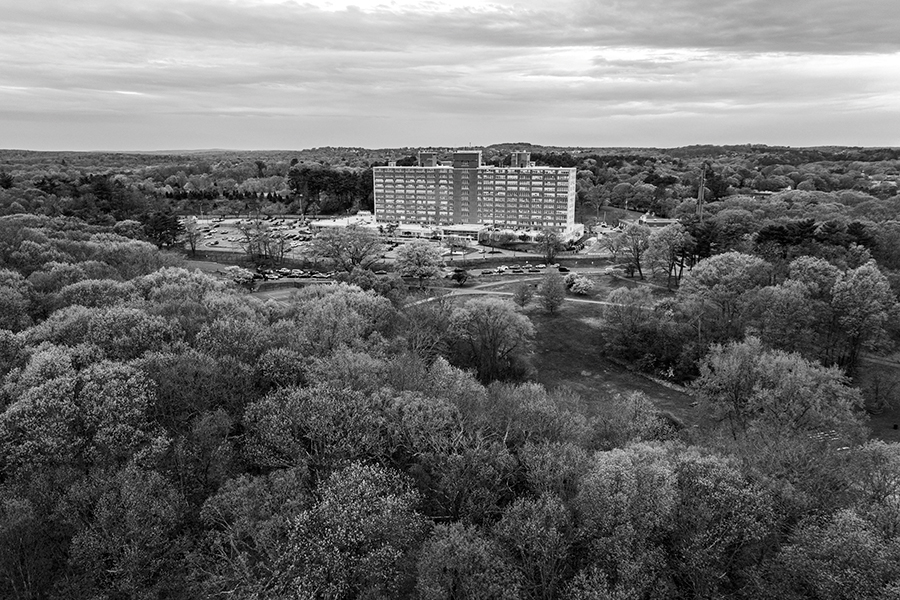
Photo by Aram Boghosian
The auditorium at Boston’s English High School was packed when Zack DeClerck strode to the microphone one April evening in 2018. Before him was a sea of progressive activists from Jamaica Plain, Roxbury, and Dorchester—the kinds of people he was used to addressing in his role as an addiction-recovery advocate for Boston’s homeless community. But tonight, something felt different.
There was tension in the air. Unlike prior meetings DeClerck had attended throughout the years, this was not a unified, feel-good crowd. Usually staunch allies on initiatives aimed at making the city a more livable, just, and equitable place, the people in attendance were suddenly at odds over the future of a 13-acre patch of ground in Franklin Park, the longtime home of the Lemuel Shattuck Hospital.
At issue were the state’s plans for the site of the hospital, which sits entirely within the borders of Franklin Park, a vast expanse of green space in the geographic center of the city that was designed by the father of landscape architecture, Frederick Law Olmsted. Armed with a PowerPoint presentation and fancy schematic drawings, state officials had earlier explained that the hospital, built in the early 1950s and now in disrepair, would soon be razed. A new human services campus with some 75 to 100 supportive housing units, substance abuse treatment facilities, and mental health services would be erected in its place. Roughly half of the audience beamed at the plan that they had helped concoct, confident it would lend a much-needed hand to some of Boston’s most vulnerable citizens.
Others, including Emerald Necklace Conservancy president and environmental advocate Karen Mauney-Brodek, were fuming. Feeling blindsided, they stood up and demanded to know why, in a part of the city surrounded by dense and largely treeless streets, the state wasn’t returning the property to the park as desperately needed open space for residents of Roxbury, Mattapan, and Dorchester. Their idea, they argued, was actually the best way to help some of the city’s most vulnerable citizens, many of whom live in insufferable concrete heat islands, while at the same time combatting climate change.
DeClerck, an Egleston Square resident, also loves Franklin Park and the idea of creating more green space. But the opposition shocked him, especially since it was coming from so many familiar and friendly faces in the city’s progressive community. “This is an ideal location for recovery services and supportive housing,” he says. “The park is awesome for people trying to heal and receive care. These are really hard-to-place programs. We have an opportunity with state-owned, deeded land, and to miss that opportunity would be so tragic.” Despite DeClerck’s enthusiastic endorsement, however, the opposition remained unconvinced, demanding that Governor Charlie Baker scrap his plans and restore the park to the people.
And then…not much happened for a while. Following the contentious meeting, the debate quietly simmered for two years before finally boiling over this spring, after a wider swath of environmental interest groups and advocates, including former Massachusetts governors Michael Dukakis and William Weld, caught wind of the dispute and launched a campaign to put a stop to Baker’s plans. Arguing that Olmsted, who created Franklin Park in the late 1800s, had always intended the parcel to be part of the park, they suggested an alternative site for the hospital with the backing of researchers from Northeastern University—which only served to bring more angry activists into the fracas and further divide some of the most progressive interest groups in the city.
The battle for Franklin Park, as it turns out, has all the makings of a classic Boston political rumble: It pits two former governors against the current one, environmentalists against housing advocates, friends against friends, and neighborhoods against each other. The scrum is reaching a fever pitch as three epic crises affecting city living—the opioid epidemic, homelessness, and climate change—and the dire need to address them converge, dividing groups that usually work in unison and raising questions about just who gets a say in Boston’s future.
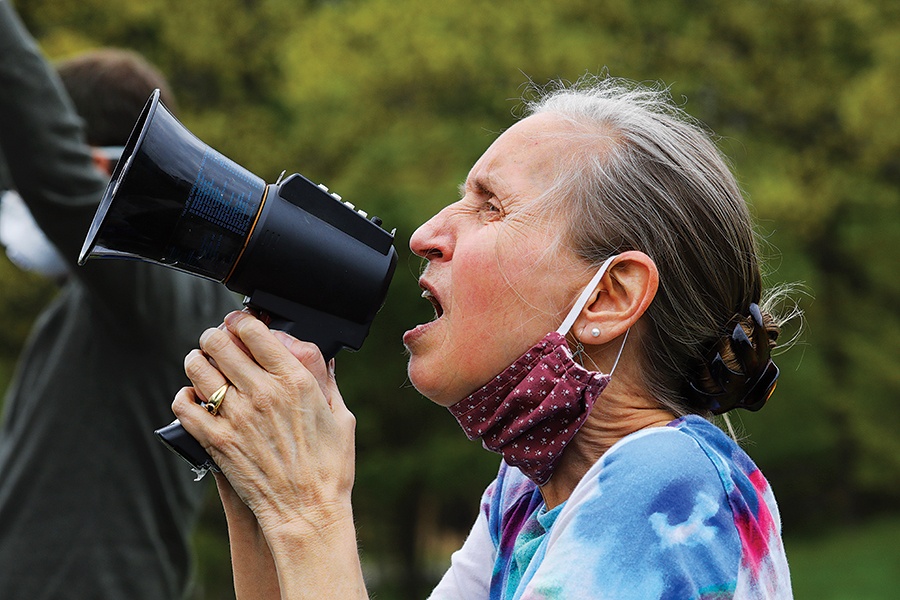
Mental health and homeless activists and those concerned about the ongoing catastrophe at Massachusetts Avenue and Melnea Cass Boulevard support Governor Baker’s plan for a bigger and better human services campus on the Shattuck land. / Photo by The Boston Globe/Getty Images
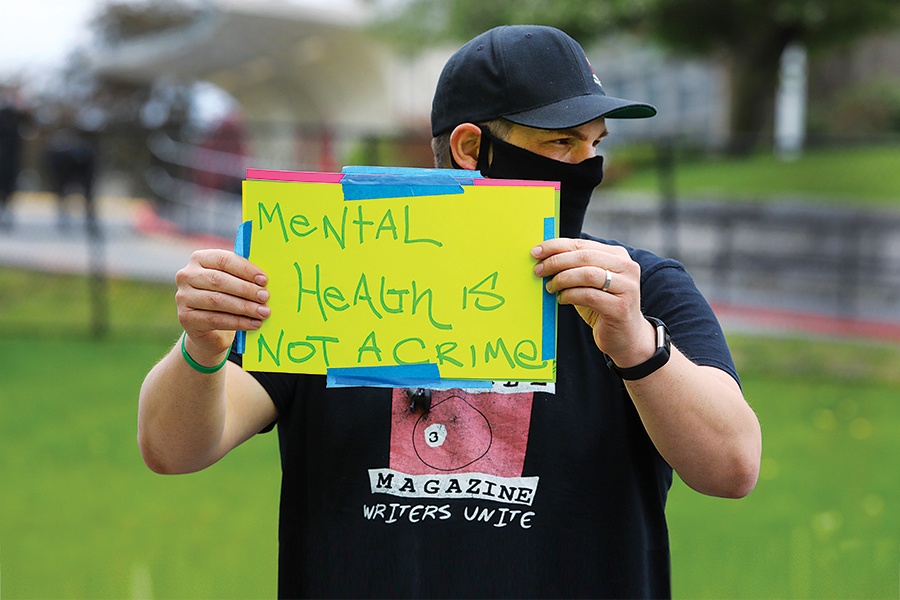
Photo by The Boston Globe/Getty Images
The heart of the conflict over Franklin Park lies some 4 miles away from its lush and leafy rolling hills, at the broken intersection of Massachusetts Avenue and Melnea Cass Boulevard in the South End. There, a tent city—littered with shopping carts and half-conscious people in the throes of drug addiction splayed out on the ground in sleeping bags and blankets—has taken over several blocks of the neighborhood. An apocalyptic scene with seemingly no solution, the city has failed over and over again to clean it up. The area is also becoming increasingly violent—five people have died from stabbings there so far this year.
When Kathy Brown, coordinator of the Boston Tenant Coalition, wants to illustrate the urgent need to rebuild the Shattuck, she simply points to the human wreckage at Mass. and Cass. “The need is so great, and it’s only been worsened by the pandemic,” says Brown, an advocate for supportive housing and homeless services. “The services are so critical, and they’re there [at the Shattuck] now. Treatment services, the emergency shelter is there now.”
The roots of the crisis at Mass. and Cass can be traced to 2014, when the Long Island Bridge that connected Quincy to the island closed, forcing the sprawling, 35-acre public health campus owned by the city of Boston there to evacuate. In total, 19 buildings on the island—including homeless shelters and mental health and substance-use-disorder facilities—were shuttered. Many of the essential social services, including the overnight homeless shelter, have disappeared. In no time, the people who might once have been treated on Long Island began to congregate at Mass. and Cass, in the vicinity of Boston Medical Center, a homeless shelter, and a series of methadone clinics. Then COVID-19 hit, plunging the area further into chaos and tragically exposing the city’s desperate need for housing, substance abuse treatment, and mental health services.
Much of this is offered at the Shattuck, which was built in the 1950s to house polio and cancer patients. Set between busy Morton Street and Circuit Drive, which winds through Franklin Park, the hospital is a 10-story building surrounded by chain-link fencing that sharply separates it from the park. Just steps away from the imposing cement slab building, friends play tennis on nearby courts, families relax on blankets spread across the cool grass, and older men sit on benches deep in contemplation over chess boards.
As the hospital has fallen into disrepair, its services have also declined. In 2012, the medical campus’s administrative building was closed after state inspectors found crumbling stairs, roof damage, broken elevators, outdated plumbing, and other problems. As of now, there is still a homeless shelter, run by the Pine Street Inn; a job-training program; and a methadone clinic on the campus, along with 260 hospital beds for medical and psychiatric patients and prison inmates.
When state officials realized that the Shattuck was falling apart, they concluded it would cost too much to fix and decided to raze the decaying building by 2024. (The Pine Street Inn facility, the methadone clinic, and three other private health service vendors were slated to stay in their current locations, adjacent to the soon-to-be-razed hospital.) The plan was to relocate some of the hospital’s services to a site owned by Boston Medical Center while a yet-to-be selected private developer built a bigger hospital in its place featuring up to 100 units of supportive housing and behavioral health services.
Despite a promise to integrate the campus with Franklin Park by incorporating green space, including new bike and pedestrian paths, the initial plans were enough to galvanize neighbors and divide activists with competing visions for the park. But when a revision was announced in 2019, all hell officially broke loose. At a public hearing at the Franklin Park golf clubhouse, state officials made a surprise announcement: They were going to triple the size of the construction, to 600,000 square feet. There would now be more services at the hospital than ever before, something advocates such as Brown knew couldn’t come soon enough. What neither she nor anyone in her camp knew was that a formidable army of opponents were assembling to make sure that none of it ever happened.
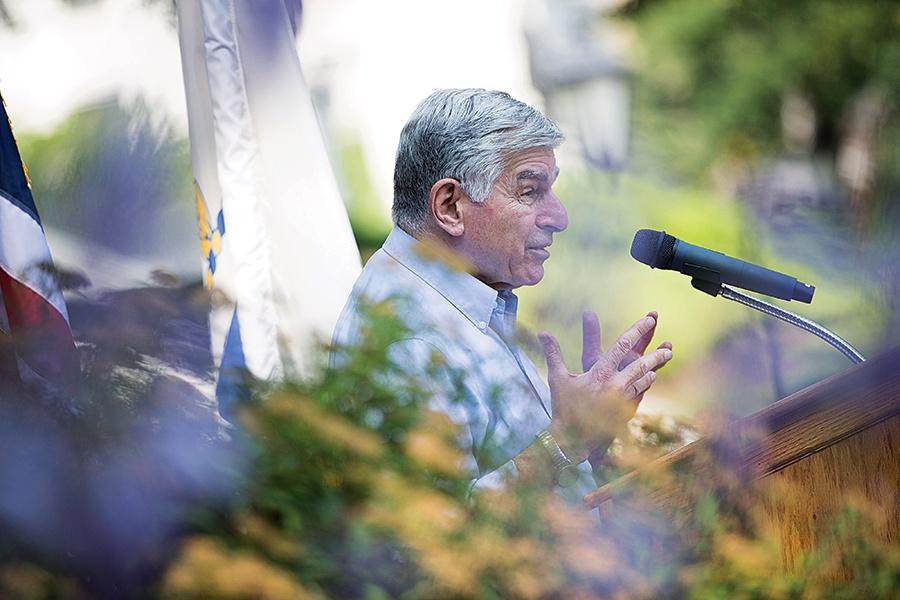
As a young man, Michael Dukakis helped build Shattuck Hospital. Now the former governor is fighting to see that space returned to the park. / Photo by The Boston Globe/Getty Images
On a hot summer day in 1952, a diminutive 19-year-old Swarthmore College student from Brookline pulled his hard hat over his bushy dark hair and walked across Morton Street to a construction site inside Franklin Park. He was working as a laborer for the summer and had been assigned to a crew building a new state hospital for polio and cancer patients. It was the height of the polio epidemic, and he knew the state needed space to treat sick and infectious patients. But looking around at the rolling fields and nearby Scarboro Pond, the man who would go on to become governor of Massachusetts was already thinking like someone who had bigger ideas for the state than the people currently in charge. Why on earth would the government choose a pristine park as the site for a massive state hospital? a young Michael Dukakis asked himself. “I never thought it made sense at the time,” Dukakis, now 87, recalls. “We were taking 13 precious acres of parkland out of the park system, when there were lots of alternatives, especially in those days. There was no reason under the sun to do that.”
Given the history of the space, Dukakis’s reservations made sense. In the early years of this vast piece of wildland, the essayist, philosopher, and conservationist Ralph Waldo Emerson lived in a cabin atop Schoolmaster Hill and taught at a nearby school. By the mid-1800s, it was declared an official public park, later named after Benjamin Franklin. From 1878 to 1896, Frederick Law Olmsted, the visionary landscape architect who created Central Park in New York City, set his sights on Boston, leading a bold plan to create a connected, citywide park system that would protect Boston from overdevelopment and forever dedicate hundreds of acres to nature. The 527-acre Franklin Park was its majestic centerpiece.
When Dukakis learned in 2019 that the state wasn’t planning to turn the Shattuck site back into parkland, he thought back to his time working on the construction crew. Given the current global climate crisis, the idea of forgoing the opportunity for more tree cover in Boston seemed even more senseless today than it did then. So he hunkered down with Weld; renowned activist Ted Landsmark, director of the Dukakis Center for Urban and Regional Policy at Northeastern; and the powerful and politically connected Emerald Necklace Conservancy to fight for the return of the Shattuck campus to its rightful place as part of Franklin Park’s green space.
That’s a lot of support and firepower behind a park that has long been treated as the ugly stepsister to Boston Common. Even though Franklin Park is 10 times the size of the Common and is in the city’s geographic center, the Common is located in the heart of Beacon Hill and has been fiercely protected by wealthy, brownstone-dwelling residents for generations. Now, Franklin Park had its own defenders—and at just the right time: Thanks to COVID, its open spaces are more popular than ever, and the park is in the midst of a long-overdue $28 million overhaul involving landscape architecture, infrastructure, and programming.
As the debate raged on, what was once a neighborhood matter began to garner national attention. Charles Birnbaum, president, CEO, and founder of the Washington, DC–based Cultural Landscape Foundation, notes that Boston has a “rare opportunity” to reclaim a piece of natural history and honor Olmsted’s environmental innovation. “This is the perfect opportunity for the city to send a signal that parkland is precious,” he says, adding that “when it’s gone, it’s gone.”
If the pro-park and climate justice advocates hoped to prevail, though, they knew they needed a proposal for another hospital location. That was when the fight for Franklin Park became an all-out war.
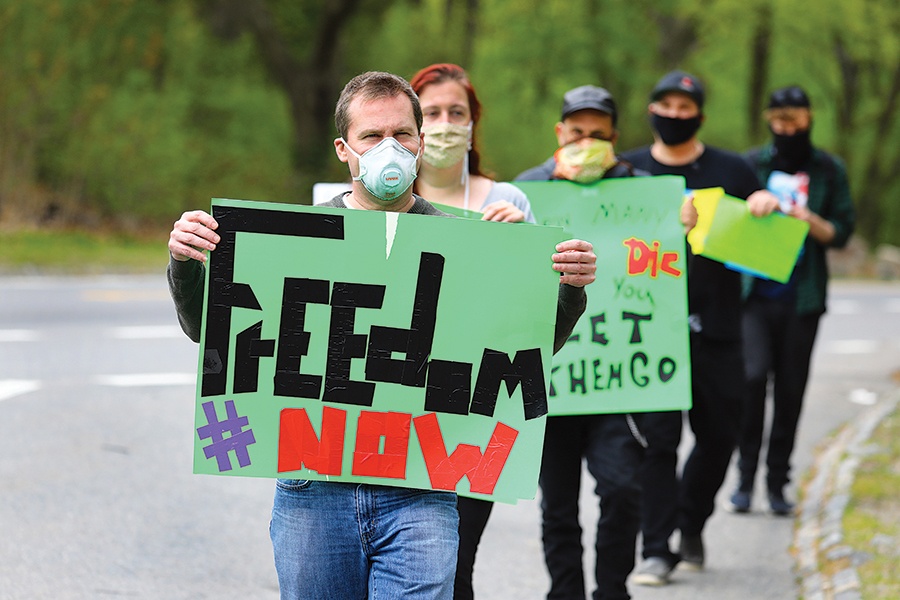
Climate and green-space activists want to see the 13 acres where Shattuck Hospital currently stands returned to Franklin Park. / Photo by The Boston Globe/Getty Images
This April, the open-space alliance announced what its members touted as a win-win for the impasse over the Shattuck. After engaging Northeastern University urban planning students to research alternative sites for the hospital, the pro-park advocates claimed they had found it: the Arborway Yard, a blighted, 18-acre patch of land in Forest Hills. In a city with limited space, though, one group’s solution can be another group’s nightmare.
The site is currently being used as a temporary bus yard—temporary, as in for the past 20 years. Back in 2001, with the help of a Jamaica Plain community group, the city signed a memorandum of understanding with the MBTA that would develop the site for a new bus facility, affordable and market-rate housing, youth recreation areas, and significant green space. For decades, J.P. neighborhood groups have been working with the MBTA to stay true to the plans for this site, which has been both an eyesore and an illegal dumping ground. The $200 million project, which now includes a charging and maintenance facility for electric buses, has yet to be funded by the MBTA, but is said to be a key part of the T’s stated goal to slash its bus fleet’s carbon emissions 80 percent by 2032.
To many, the proposal seemed like a good use for the site—until both former governors dove headfirst into the brouhaha, speaking passionately during an April public hearing over Zoom and calling on the state to kill its Shattuck plan and move everything to the Arborway Yard. That didn’t fly with residents of J.P., many of whom resented the idea of a piece of land in their neighborhood becoming part of the Shattuck fight. “Most people view the Arborway Yard as a blight. It’s unsightly,” says Kevin Rainsford, chair of the Jamaica Plain Neighborhood Council. But “people really want to move forward with having a permanent bus facility built. My fear is what the Emerald Necklace Conservancy is doing is really slowing down that process.”
There’s also a level of frustration among those in Jamaica Plain who see the conservancy’s meddling in the Arborway Yard project as arrogant big-footing by a powerful outside group that isn’t part of the community. And it’s hard to ignore that in an ironic twist, the climate change activists looking to return the Shattuck site to green space are now interfering in a plan that is central to the MBTA’s goal to bring a more climate-friendly bus service to the majority of Boston residents.
Despite all of the drama, state officials are planning to put the Shattuck project out to a public bid this fall. Mauney-Brodek, for her part, says the conservancy is ready to dig in and challenge the state—and anyone else—every step of the way. At the same time, Dukakis said he’s urging Weld to talk to Baker—a fellow Republican—about reconsidering the plan. A Baker spokesman didn’t respond to a request for comment, which makes sense, given that the governor’s political future may be somewhat tied up in the fate of Franklin Park. Though Baker has yet to announce whether he’s running for reelection next year, environmentalists—especially the deep-pocketed supporters of the Emerald Necklace and the two former governors—will ensure the park is an issue on the campaign trail if he does decide to move forward.
It isn’t just the governor who stands to get ensnared in the melee. Both of Boston’s mayoral candidates have deep ties to progressive politics and allies on both sides of the debate. Whoever emerges the victor will be left to muscle the Baker administration to find a solution, or possibly a middle ground.
Regardless of who wins the battle—whether Franklin Park becomes 13 acres larger or smaller, whether there are human services at the Arborway Yard or a bus-charging station and affordable and market-rate housing—there will be plenty of scars that cut through the city’s activist community. Perhaps no one feels this divide as keenly as longtime Dorchester activist and former healthcare executive Bill Walczak. He spent a career working on issues of homelessness, mental health, and substance abuse, including as the CEO of the South End Community Health Center and founder of the Codman Square Health Center, yet finds himself on the side of the green space activists who want to see the Shattuck returned to Franklin Park. “We’ve pitted people who want to see parkland and open space against human service advocates,” he says. “That, to me, is so unnecessary.”
With so much political volatility at the city and state levels, and so many activists on both sides committed to their cause, the debate is putting everyone’s clout to the test. As the city struggles to deal with the carnage at Mass. and Cass and a battle brews over how best to safeguard the city from climate change, whatever happens at the Shattuck site just might shine a light on who really has the power to decide Boston’s future.